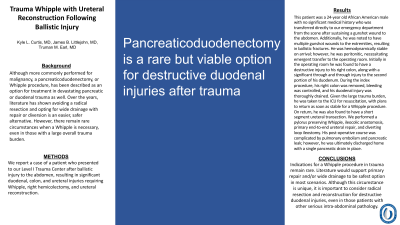HPB
Category: Quickshot Oral Session 12
Quickshot Oral : Quickshot Oral Session 12
TRAUMA WHIPPLE WITH URETERAL RECONSTRUCTION FOLLOWING BALLISTIC INJURY
Sunday, February 12, 2023
7:00am - 8:00am East Coast USA Time


Kyle Curtis, MD
Resident
University of MIssissippi Medical Center, United States
Kyle Curtis, MD
Resident
University of MIssissippi Medical Center, United States
Presenter(s)
Principal Contact(s)
Objectives: Although more commonly performed for malignancy, a pancreaticoduodenectomy, or Whipple procedure, has been described as an option for treatment in devastating pancreatic or duodenal trauma as well. Over the years, literature has shown avoiding a radical resection and opting for wide drainage with repair or diversion is an easier, safer alternative. However, there remain rare circumstances when a Whipple is necessary, even in those with a large overall trauma burden.
Methods: We report a case of a patient who presented to our Level I Trauma Center after ballistic injury to the abdomen, resulting in significant duodenal, colon, and ureteral injuries requiring Whipple, right hemicolectomy, and ureteral reconstruction.
Results: This patient was a 24-year old African American male with no significant medical history who was transferred directly to our emergency department from the scene after sustaining a gunshot wound to the abdomen. Additionally, he was noted to have multiple gunshot wounds to the extremities, resulting in ballistic fractures. He was hemodynamically stable on arrival; however, he was peritonitic, necessitating emergent transfer to the operating room. Initially in the operating room he was found to have a destructive injury to his right colon, along with a significant through and through injury to the second portion of his duodenum. During the index procedure, his right colon was removed, bleeding was controlled, and his duodenal injury was thoroughly drained. Given the large trauma burden, he was taken to the ICU for resuscitation, with plans to return as soon as stable for a Whipple procedure. On return, he was also found to have a short segment ureteral transection. We performed a pylorus preserving Whipple, ileocolic anastomosis, primary end-to-end ureteral repair, and diverting loop ileostomy. His post-operative course was complicated by pulmonary embolism and pancreatic leak; however, he was ultimately discharged home with a single pancreatic drain in place.
Conclusion: Indications for a Whipple procedure in trauma remain rare. Literature would support primary repair and/or wide drainage to be safest option in most scenarios. Although this circumstance is unique, it is important to consider radical resection and reconstruction for destructive duodenal injuries, even in those patients with other serious intra-abdominal pathology.
Methods: We report a case of a patient who presented to our Level I Trauma Center after ballistic injury to the abdomen, resulting in significant duodenal, colon, and ureteral injuries requiring Whipple, right hemicolectomy, and ureteral reconstruction.
Results: This patient was a 24-year old African American male with no significant medical history who was transferred directly to our emergency department from the scene after sustaining a gunshot wound to the abdomen. Additionally, he was noted to have multiple gunshot wounds to the extremities, resulting in ballistic fractures. He was hemodynamically stable on arrival; however, he was peritonitic, necessitating emergent transfer to the operating room. Initially in the operating room he was found to have a destructive injury to his right colon, along with a significant through and through injury to the second portion of his duodenum. During the index procedure, his right colon was removed, bleeding was controlled, and his duodenal injury was thoroughly drained. Given the large trauma burden, he was taken to the ICU for resuscitation, with plans to return as soon as stable for a Whipple procedure. On return, he was also found to have a short segment ureteral transection. We performed a pylorus preserving Whipple, ileocolic anastomosis, primary end-to-end ureteral repair, and diverting loop ileostomy. His post-operative course was complicated by pulmonary embolism and pancreatic leak; however, he was ultimately discharged home with a single pancreatic drain in place.
Conclusion: Indications for a Whipple procedure in trauma remain rare. Literature would support primary repair and/or wide drainage to be safest option in most scenarios. Although this circumstance is unique, it is important to consider radical resection and reconstruction for destructive duodenal injuries, even in those patients with other serious intra-abdominal pathology.

